Atomic Bomb Waste Could Leak into the Sea
Air Date: Week of January 26, 2018

The Runit Dome on Enewetak Atoll contains chunks of plutonium from misfired atomic weapons, radioactive soil, and other debris from the nuclear testing that took place there between 1946 and 1958. (Photo: Greg Nelson)
The U.S. military conducted nuclear weapons tests in the Marshall Islands in the 1940s and 50s, leaving a legacy of radioactive waste could be washed into rising seas. Australian Broadcasting Corporation reporter Mark Willacy tells host Steve Curwood that sea water is infiltrating the Runit Dome, an atomic bomb waste repository on a remote Marshall Island atoll. This poses a potential risk of radiation exposure for the small local population, though US experts insist its plutonium contamination levels aren’t dangerous.
Transcript
CURWOOD: It’s Living on Earth, I’m Steve Curwood. “We are nothing without our islands,” wrote poet Kathy Jetnil-Kijiner but, the Marshall Islands face uncertainties beyond the rising seas. In the 1940s and ’50s, these remote coral atolls were ground zero for atomic weapons testing, and now the sea is infiltrating a nuclear waste dump. Islanders evacuated from Enewetak Atoll were allowed to return in the 1980s, but as Mark Willacy of the Australian Broadcasting Corporation documented, the encroaching ocean is raising concerns about contamination from nuclear weapons waste. He joins me now from Brisbane – Mark, welcome to Living on Earth!
WILLACY: Thanks, Steve.
CURWOOD: So, where is the atoll? And what is it like?
WILLACY: Well, the atoll is in the central Pacific, basically in the Marshall Islands. And obviously the Marshall Islands is this huge expanse. It's over a 1,000 islands spread over 2,000 square kilometers so, it's in one of the even most remote parts of the Marshall Islands in the far west of the country, and to get there is a feat in itself, Steve, put it that way. We had to hire an old prop plane and fly across a 1,000 kilometers of open ocean and land on an old US military air strip. And it's a beautiful place, it's just extremely remote, extremely isolated.
CURWOOD: So, what are we talking about in terms of people who live there or near there?
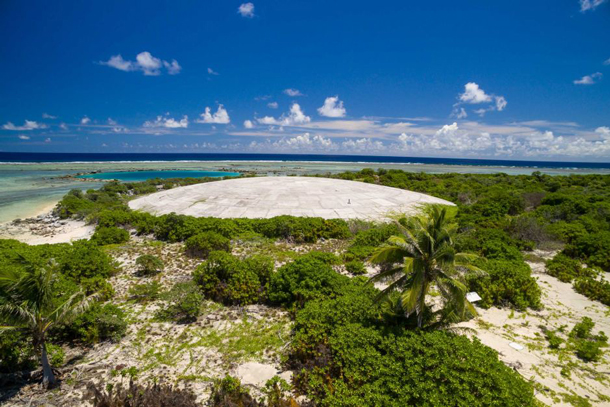
Willacy describes the concrete cap over nuclear waste as looking like an extra-terrestrial flying saucer. (Photo: Greg Nelson)
WILLACY: Well, before we got there, we were told that there’s a population of about 600, but when we arrived it appeared that the population was no more than 200, and we did ask around about what had happened to the population. A lot of people do move away for work. There is no work on the island, and so there’s a very small population there and they do feel quite isolated given that the air services are not regular, the barge that brings over their supplies is not regular. You really do feel like you're on the – at the end of the Earth.
CURWOOD: So, what happened on Enewetak during the nuclear testing?
WILLACY: Well, obviously Bikini Atoll is probably the most famous site of the US nuclear testing. Now, Bikini is about 300 kilometers to the east of Enewetak, but in fact, at Enewetak there were more nuclear tests than Bikini, in fact, nearly double the amount of nuclear tests between 1946 and 1958. There were actually 43 nuclear detonations during that period, including some of the largest bombs ever detonated, some thermonuclear devices, some so big they vaporized entire islands. So they were extremely toxic. In fact, we found an old NBC report from the ’70s during the cleanup of those islands, and it made the point that it was the most toxic place on Earth.
CURWOOD: Mark, why is there a dome filled with nuclear waste on this low lying Pacific atoll?
WILLACY: Well, it's a good question. Before the nuclear testing started in 1946, the US military moved all the people off in Enewetak like they did at Bikini Atoll. Now, they detonated all these nuclear devices, and over the period, the people wanted to return, and so the United States decided in the 1970s that it would launch a cleanup of parts of the atoll, so they could at least get some of the people back on some of the islands. So, in 1977, about 4,000 US servicemen was sent in to clean up as many of the islands as they could, essentially. And one of the ideas that they had was to throw a lot of this old radioactive debris, soil, bits of plutonium, in fact, from a misfired bomb, into a crater caused by one of the detonations, and so that's what they did. In over a three to four year period, they basically put, I think it was 85,000 cubic meters of radioactive soil and debris into this all crater and then they decided to cap it. Now, to cap it they put about a foot and a half thick concrete dome over the top, and if you look at this thing from the air it looks like one of those 1950s flying saucers that crash-landed on this remote Pacific atoll.
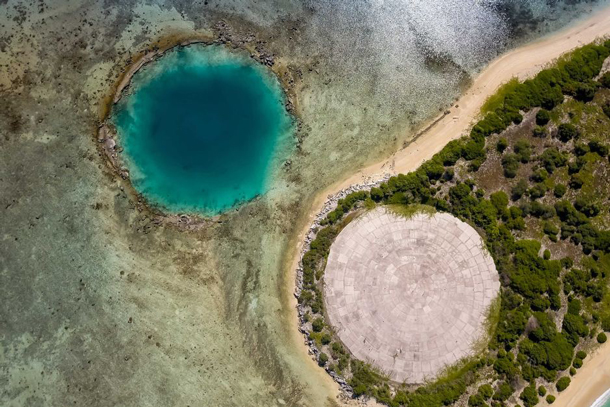
The Runit Dome, itself built on top of a detonation crater, lies next to another one of about the same size. (Photo: Greg Nelson)
CURWOOD: Now, you mentioned plutonium. So, plutonium isn't hyper radioactive. You could be shielded from it, but, boy, if the tiniest amount gets into water or into people, into living things, that's it. It's really highly toxic.
WILLACY: That's right it has a radioactive half-life of about 24,000 years. So, this plutonium was actually created or spread around the atoll in the northern islands by the misfiring of a bomb. So, in other words this nuclear device did not detonate the way it was supposed to detonate, and there were 400 chunks of this plutonium spread across the island, and again, in the 1970s when these US servicemen were sent there to clean it up, they told stories of having to go and put it into plastic bags and then they threw these plastic bags into this bomb crater that was then capped with the dome. So, it is highly toxic. I believe about a one millionth of a gram is enough to kill a human being, so it's something that you certainly do not want to be exposed to.
CURWOOD: No, you certainly no want to inhale it or touch it. So, of course, the atoll is at sea level. So, how much have sea levels risen at Enewetak and why is there now concern about water infiltrating that dome that's capping the nuclear waste?
WILLACY: Yeah, the Marshall Islands, one of the most low-lying countries on the planet. They have an average height of six feet above sea level, so you're talking about a country that is at the forefront at the fight against climate change, and we've seen big storm surge events, other types of flooding in the Marshall Islands, that has seen water, sea water, come clean across some certain atolls. Now, at Enewetak when they built this dome in the late 1970s, it was obviously no factoring in climate change and sea level rise is caused by climate change. So, it was built right next to the shore on the ocean side of this island in Enewetak and seawater is penetrating the underside of the dome because when they threw all this material into the old bomb crater they didn't line the old bomb crater with anything. They were supposed to line it with concrete, but that never happened because of cost considerations.
So, as the sea level has risen, the groundwater level has risen and therefore you have groundwater penetrating inside the dome because a lot of this atoll is obviously sand, it's coral, it's permeable material. Not only that, the United States itself in a 2013 report, a government report, warned that this dome could smash apart because of the increased ferocity of typhoons and other big storm events, not that the Marshall Islands is the recipient of too many of these typhoons, but they do get the odd typhoon that causes trouble, so the dome is really very vulnerable to climate change, and this is something the Marshall Islanders themselves have been really trying to reinforce for years, and to try and get lawmakers in the United States to take up their call.
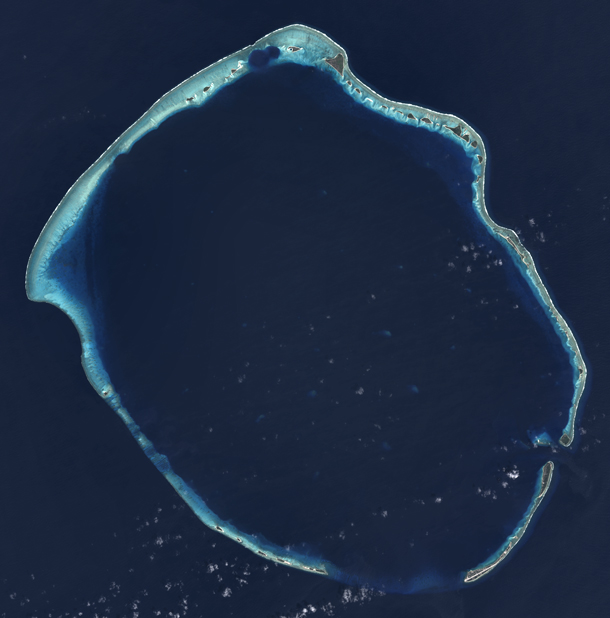
Enewetak Atoll is a collection of 40 islands in a ring atop an extinct, sunken volcano in the Pacific Ocean. (Photo: NASA/USGS)
CURWOOD: So, if a typhoon did hit Enewetak, what would happen to all that contaminated material inside the dome?
WILLACY: Well, if it was to be breached or there were some sort of catastrophic failure of the dome ... there have been written warnings, again, this government report in 2013 that that could see radioactive material sort of leeching out in large quantities. Having said that, the United States government has also said, “Look, if there was this catastrophic breach of the dome, and this material was to wash out, we do not believe that it would cause any greater environmental damage to the outside environment that has already being caused by the bomb tests.” In fact, the lagoon formed by the Enewetak atoll, the second largest ocean lagoon in the world, has a lot of plutonium in the sediment, in the bottom of it, and the United States government is saying, well, look the dome, yes, it serves a purpose, but if it was to be breached, we doubt it would create much more damage. Now, you talk to Marshall Islanders and they say, Well, why build the dome in the first place ... it's obviously got plutonium in it, it's highly toxic, we do need that contained and if that was to spill out, well, we're the people who would have to be evacuated once again from Enewetak which is our island home.
CURWOOD: So, who has checked into the US government's claim that if the dome breaks up there won't be a contamination problem there at Enewetak?
WILLACY: We've got the Lawrence Livermore Laboratory based out of California. They have been doing groundwater-monitoring tests at Enewetak. They have installed in recent years a number of monitoring facilities, and you can see these pipes that come out of the dome and outside of the dome, but in terms of dealing with the structural issues of the dome itself, there's been no moves to try and reinforce the dome, to try and make sure that the concrete can withstand a big typhoon or a big storm event. Now, that's going to cost potentially hundreds of millions of dollars, and for the Marshall Islanders to do it themselves would be impossible. This is a small Pacific nation, quite impoverished by Western standards. So, it really is not just an environmental problem, it's a political stalemate as well.
CURWOOD: So, how has all this radioactivity affected the health and livelihoods of the people who live there?
WILLACY: The health impacts were largely mitigated by the fact that the people were taken off the island ahead of the nuclear testing. I think the Marshall Islanders who were most affected by the nuclear testing weren't the people on Bikini or Enewetak where the testing was taking place because they were taken off the island. You did have some very severe health impacts from islanders who were downwind of a couple of the biggest bomb tests, including the largest nuclear detonation the United States ever carried out, and that was a bomb called Castle Bravo that was detonated at Bikini. The wind calculations were wrong and the wind blew over an island called Rongelap, and the people were there for four or five days before the United States military evacuated them, and a lot of people became very ill. After that, there were cancers detected. There are even reports of birth defects among the children.
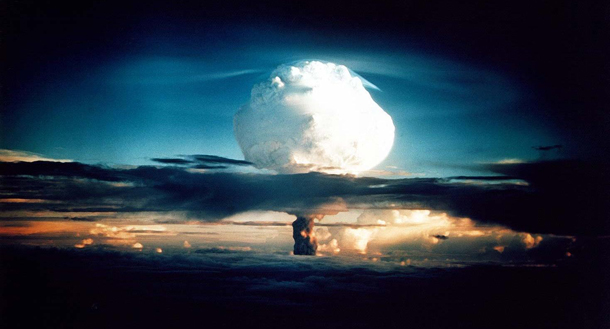
Nuclear weapon test of “Mike,” the first hydrogen bomb ever tested, on Enewetak Atoll. (Photo: National Nuclear Security Administration /Nevada Site office)
But in terms of the people of Enewetak where we were visiting, there was no great evidence or examples of problems with health. Having said that, the islanders did introduce us to a couple of the children who they say have some sort of disabilities that are associated with exposure to radiation through soil and food. Now, we're not scientists and we're definitely not trained in radioactivity and contamination, but on the island itself of Enewetak, I suppose to give you an example of the fact that people are being monitored, is a laboratory set up by the Lawrence Livermore Laboratory. And it has a whole of body count radiation machine there that if you do go to one of these contaminated northern islands, you are supposed to come back, you are supposed to get checked through this body counter machine. However, while we were there there was a problem with the hard drive and it hadn't been operating for some weeks as far as the locals were telling me.
CURWOOD: So, of course, there's various kinds of radiation there, but much of it will be around literally for thousands of years, so it's not like ignoring this means that it'll go away. So, what could be done at this point about this leaking dome?
WILLACY: Well, what the Marshall Islands government would like to see is the United States take responsibility for what it sees as a United States problem. Now, the United States in 1986 did a deal with the Marshall Islands, that the Marshall Islands would take over the running of its own affairs. It paid the Marshall Islands about $150 million dollars, and said, “Right, all deals are done, there's no more claiming of compensation or anything like that.” So, from the perspective of some in the United States government, there is no obligation of the United States to – to come back and clean up this dome or to fix it up. So, I think we're at a political stalemate, as I said before, Steve, and that's the problem.
The Marshall Islands as a nation has very little clout in any international forum at all, let alone when it's dealing with one of the most powerful nations on Earth. They have tried through a number of lawmakers in the Congress to get bills put forward. I believe they have been unsuccessful. So, I think we're just at a situation where the Marshallese are warning, look, right, well just wait for this thing to crack open or to smashed totally apart, and then, I suppose we'll go in and we have to evacuate the people of Enewetak again. Look, there's only a few hundred of them. Why would the world care?” Unfortunately, this is a nation where its nuclear legacy is colliding directly with the climate change future and that dome is the intersection of all of that, and they've got young activists in the Marshall Islands trying to take up the fight and they're saying, “Look, it's amazing. I'd rather live on a nuclear contaminated island than no island at all.” The Runit dome, as it's called, is already very much in the firing line of these rising seas.
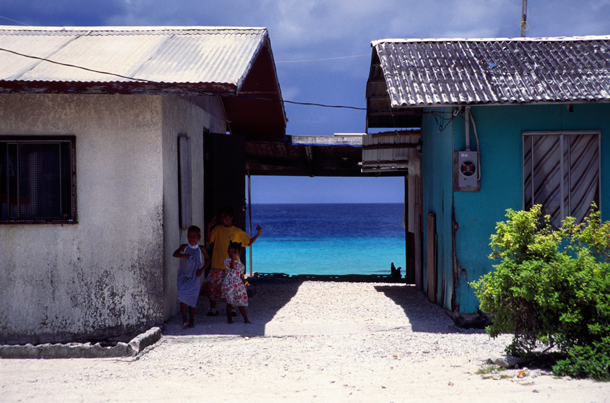
The Marshall Islands’ entire territory lies within a few feet of current sea level, and projected sea level rise under the most likely climate change scenarios will inundate the island nation. (Photo: Stefan Lins, Flickr CC BY 2.0)
CURWOOD: What do Marshall Island attorneys, what do the lawyers say might be recourse against the United States at this point?
WILLACY: Well, that's a good question. We did actually go to the nuclear claims tribunals in the capital Majuro while we were there, and that has basically run out of funding. Now, that funds victims of the testing, that of people who have lost their homes, who have health claims to put against the United States government. It made $2.3 billion dollars worth of claims, however, only a few million dollars was ever handed out. So, if they can't even get justice for the health issues and for losing their homes, then I doubt that they're even going to try and launch any sort of suit against the United States government for some sort of redress or some sort of compensation or some sort of monies to try and reinforce the dome. I think the Marshall Islanders know they've lost, and you go into the nuclear claims tribunals there in Majuro the capital and there's just boxes and boxes and boxes of claims just gathering dust that will never be acted upon, and I think that's a great visual symbol of where the United States is in terms of how it fulfills its obligations.
CURWOOD: Some might say this is criminal.
WILLACY: Some Marshallese certainly say it's criminal, but again the United States said, look, we did a deal in 1986 with the Marshall Islands government to basically grant them independence and they gave them a check for $150 million dollars and said, right, that's it, deal is done, we'll leave it at that.
CURWOOD: Sounds like they were tricked because if they were still a territory of the United States they would be in a much stronger position.
WILLACY: That's exactly right, and they point to – to the United States itself, and they point to the downwinders, those people in places like Nevada who were exposed to nuclear fallout from the atomic testing program on domestic soil, and the fact that those people in Nevada – and I believe other places like Arizona even – were swiftly compensated and compensated much more generously than the Marshall Islands people. So they do feel like second class citizens, they do feel like the Americans took care of their own, and just left them dangling, if you like, and to deal with this toxic legacy.
CURWOOD: Mark Willacy is a reporter with The Australian Broadcasting Corporation. Mark, thanks so much for taking the time with us today.
WILLACY: Many thanks, Steve!
CURWOOD: We contacted the Department of Energy’s Lawrence Livermore Labs, which has assessed the structural soundness of the nuclear dome along with independent experts. The lab says external cracks don’t affect the solidity of the protective cover but will be repaired during 2018.
Links
“The Dome,” the documentary Mark Willacy did reporting for
Australian Broadcasting Corporation: “A poison in our island”
The 2013 Lawrence Livermore report describing the state of the Runit Dome
U.S. Department of State: U.S. Relations With Marshall Islands
Living on Earth wants to hear from you!
Living on Earth
62 Calef Highway, Suite 212
Lee, NH 03861
Telephone: 617-287-4121
E-mail: comments@loe.org
Newsletter [Click here]
Donate to Living on Earth!
Living on Earth is an independent media program and relies entirely on contributions from listeners and institutions supporting public service. Please donate now to preserve an independent environmental voice.
NewsletterLiving on Earth offers a weekly delivery of the show's rundown to your mailbox. Sign up for our newsletter today!
 Sailors For The Sea: Be the change you want to sea.
Sailors For The Sea: Be the change you want to sea.
 Creating positive outcomes for future generations.
Creating positive outcomes for future generations.
 Innovating to make the world a better, more sustainable place to live. Listen to the race to 9 billion
Innovating to make the world a better, more sustainable place to live. Listen to the race to 9 billion
 The Grantham Foundation for the Protection of the Environment: Committed to protecting and improving the health of the global environment.
The Grantham Foundation for the Protection of the Environment: Committed to protecting and improving the health of the global environment.
 Contribute to Living on Earth and receive, as our gift to you, an archival print of one of Mark Seth Lender's extraordinary wildlife photographs. Follow the link to see Mark's current collection of photographs.
Contribute to Living on Earth and receive, as our gift to you, an archival print of one of Mark Seth Lender's extraordinary wildlife photographs. Follow the link to see Mark's current collection of photographs.
 Buy a signed copy of Mark Seth Lender's book Smeagull the Seagull & support Living on Earth
Buy a signed copy of Mark Seth Lender's book Smeagull the Seagull & support Living on Earth

